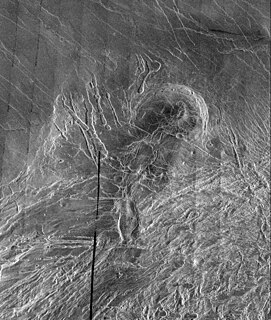Related Research Articles

Planetary nomenclature, like terrestrial nomenclature, is a system of uniquely identifying features on the surface of a planet or natural satellite so that the features can be easily located, described, and discussed. Since the invention of the telescope, astronomers have given names to the surface features they have discerned, especially on the Moon and Mars. To standardize planetary nomenclature, the International Astronomical Union (IAU) was assigned in 1919 the task of selecting official names for features on Solar System bodies.
Terra is the Latin/Italian/Portuguese term for Earth or land.
Mellish is a crater on Mars, located in the planet's southern hemisphere at 72.63°S 23.74°W. It measures 104.95 kilometers in diameter. The crater was named by IAU's Working Group for Planetary System Nomenclature in 1994, after American amateur astronomer John E. Mellish from St. Charles in Illinois.
This is a directory of lists of geological features on planets excepting Earth, moons and asteroids ordered by increasing distance from the Sun.

Ishtar Terra is one of two main highland regions on the planet Venus. It is the smaller of the three "continents", and is located near the north pole. It is named after the Akkadian goddess Ishtar.

Lakshmi Planum is a plateau feature approximately 2 million sq km ringed by rugged mountains, the surface of Venus on the Western Ishtar Terra. It is named after Lakshmi, the Hindu goddess of wealth.

Artemis Corona is a corona found in the Aphrodite Terra continent, on the planet Venus, at 35°S135°E.

Tempe Terra is a heavily cratered highland region in the northern hemisphere of the planet Mars. Located at the northeastern edge of the Tharsis volcanic province, Tempe Terra is notable for its high degree of crustal fracturing and deformation. The region also contains many small shield volcanoes, lava flows, and other volcanic structures.
Nanichi is a crater found the Magellian region on the planet Venus. It measures 19 km in diameter, and is located at +East, 0 - 360 using the planetocentric coordinate system.

Müller is a 120.5 kilometer crater in the Martian southern hemisphere, at 25.74°S, 127.89°E, located in the Terra Cimmeria region of the Mare Tyrrhenum quadrangle of Mars. According to the International Astronomical Union's Working Group for Planetary System Nomenclature, Müller is jointly named for Hermann Joseph Muller, an American geneticist and anti-nuclear weapons activist, and Carl H. Müller, a German astronomer. Ejecta from the Müller crater divides two Noachian era drainage basins.

Lada Terra is a major landmass near the south pole of Venus which is centered at 60°S and 20°E and has a diameter of 8,615 kilometres (5,353 mi). It is defined by the International Astronomical Union as one of the three "major landmasses," or terrae, of Venus. The term "landmass" is not analogous to the landmass on Earth, as there are no apparent oceans on Venus. The term here applies to a substantial portion of land that lies above the average planetary radius, and corresponds to highlands. The broad region of Lada Terra contains massive coronae, rift zones, and volcanic plains as well as many other features that scientists use to attempt to piece together the history of this complex planet. The distinctive cross-cutting relationships found in the bedding of Lada Terra have been important in realizing relative ages of the extensional belts and coronae, as well as the complex tesserae features present planet-wide. In 1990 the Venus Radar Mapper revealed the largest outflow channel system on the planet located in the northern region of Lada Terra. Although Lada Terra is generally considered a highland of Venus, the topography is much lower-lying than its northern counterparts Ishtar Terra and Aphrodite Terra. Lada Terra is named after Lada, the Slavic goddess of love.

Skadi Mons is a mountain on Venus in Maxwell Montes, at the center of Ishtar Terra. It is the highest point of the planet with an altitude of about 10,700 meters above the mean planetary radius.
The following outline is provided as an overview of and topical guide to Venus:

Annona is a Impact crater in the southern hemisphere of the dwarf planet Ceres, located at 48.14° S, 8.43° E. It has a diameter of 60 kilometres (37 mi). The crater is named after Annona, a Roman goddess of crops and of the harvest. It was officially named by the International Astronomical Union (IAU) on December 14, 2015.
Xcacau Corona is a corona in the planet Venus, in the coordinates -56 ° S and 131 ° E.

Nott Corona is a corona, a geological formation in the shape of a crown, located on the planet Venus at -32.3° N and 202° E. It is located in the Isabella quadrangle. It is named after Nótt, the Scandinavian goddess of the Earth.
References
- This list was adapted from the Gazetteer of Planetary Nomenclature